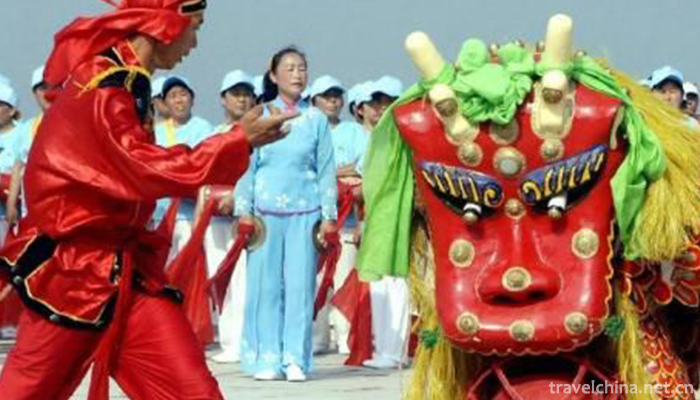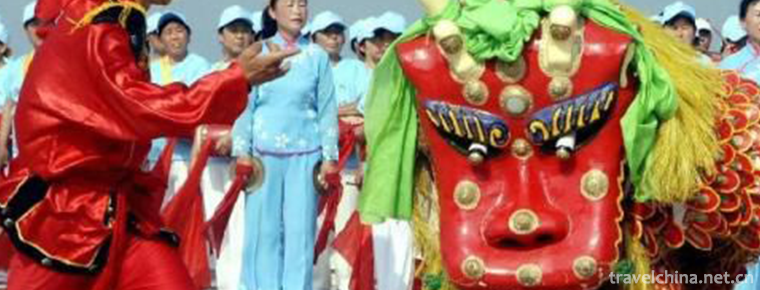kylin dance
kylin dance
Kirin dance, also known as "Wu" Kirin, is a court dance performance of the Ming Dynasty in China. It was spread among the people when the Nanming Dynasty perished. When dancing, one person dances Kylin Head and one person dances Kylin Tail, and two people cooperate with each other tacitly, so as to vividly express the joy, anger, sadness, joy, surprise, suspicion, drunkenness and sleep of the legendary Kylin. On New Year's Day, people dance Kirin to express their good wishes of welcoming good fortune and praying for good weather and national peace.
Kirin is a kind of animal representing auspiciousness in ancient Chinese legends. It is called "Four Spirits" together with phoenix, turtle and dragon. It ranks first among the "Four Spirits". There is the saying of exorcising evil spirits and avoiding ghosts among the people. People of all dynasties regard it as a symbol of auspiciousness. The image of Kirin has a history of more than 2500 years in China. For a nation, it has developed from a totem, a belief to a philosophical significance, and then into the literary field, finally to plastic arts and performing arts. This shows that Kirin has evolved from a "myth and legend" to a "cultural phenomenon". Kirin dance, as a carrier of Kirin culture and a rare kind of dance, is still active in the folk. The "Daliuzhai Kirin Dance" in Liudi Town, Suxian County, Henan Province is its typical representative. Guangdong Province is a region where Kirin dance is widely spread.
Kirin dance, which integrates music, dance, arts and crafts and acrobatics, has not only aesthetic appreciation value, but also literary, religious, folk and historical research value, which is a precious property left by our ancestors to the descendants of China.
On June 7, 2008, the Qilin Dance declared by Lankao, Huanghua and Haifeng was listed in the second batch of national intangible cultural heritage list by the State Council.
In May 2011, the "Kirin Dance" declared by Suxian, Houma, Shenzhen and Dongguan was included in the second batch of national intangible cultural heritage "Kirin Dance" projects by the State Council in the form of an expanded project list.
Historical Evolution
According to historical records such as Daming Unified Chronicle, Qixian Chronicle and Feng Family Genealogy, "Qi County Chronicle"
Lindan Dance, originally only a performing art in the palace, is called "Qilin Holy Dance", which is a necessary performance in various royal celebrations. When the Nanming Dynasty perished (1661 A.D.), Wenlin Lang Feng Weigui, who was in charge of palace culture and entertainment, returned to Lixian County, Henan Province. He brought a pair of "Kirin Peels" to the Feng people in Daliuzhai Village, Suxian County, and personally taught the skills of dancing. Kirin dance originated from the Feng family has passed on for 15 generations and has gone through more than 35 years of history. In the late Ming Dynasty, "Qilin Dance" flowed into the folk of Lixian County from the imperial court. As the Royal dance inherited by the Feng family form, it basically retained the dance style and original form of the Ming Dynasty more than 300 years ago. The teacher-inheritance relationship of Qilin Dance is special. The conditions for selecting performers are quite strict, forming performance groups, continuing from generation to generation, and emphasizing that the skills learned are not allowed to be passed on.
The Qilin Dance in Guangdong Province witnesses the migration of Hakkas from the north to the south. It is accompanied by gongs, drums and suonas. It has a typical style of Flower Fairs in the Central Plains, which is different from Lingnan music in Guangdong Province.
Similarly, it is the art and culture handed down from generation to generation by the Hakka people.
In February 2007, Kirin Dance in Suxian County was listed as the intangible cultural heritage of Henan Province.
On June 7, 2008, the Qilin Dance declared by Lankao County, Huanghua City and Haifeng County was included in the second batch of national intangible cultural heritage list by the State Council.
In May 2011, Kirin Dance declared by Suxian, Houma, Shenzhen and Dongguan was included in the second batch of national intangible cultural heritage items by the State Council in the form of an expanded project list.


-
1.Shahu Sand Lake tourist attraction
In 1996, Shahu Lake was listed as one of the 35 trump-card scenic spots in China. In 2000, Shahu Lake was designated as "National Civilized Tourism Scenic Spot" by the Central Office of Spir
Time 2018-12-12 -
2.West Mountain Scenic Spot of Guiping
Guiping Xishan Scenic Spot, National AAAA Scenic Spot, National Geopark. Located in Guiping City, southeastern Guangxi Zhuang Autonomous Region, Xishan Scenic Spots 1 km away from the outskirts of the
Time 2019-01-13 -
3.Weihai Tianmu Hot Spring Resort
Tianmu Hot Spring Resort Project invested 600 million yuan by Zhuhai Tianmu Group. A total of 35,000 square meters were opened in September 2008.
Time 2019-02-22 -
4.Percussion music
Percussion is one of the traditional Chinese instrumental music. Music played by two kinds of musical instruments, i.e. playing and playing, is commonly known as Gong and drum or drum music in Chinese
Time 2019-04-22 -
5.Lantern Opera
Flower lantern opera is a kind of traditional opera widely popular in China. Its prominent feature is that the hands are inseparable from fans and handkerchiefs, singing and dancing
Time 2019-05-04 -
6.The Making Skills of Hui Ink
Hui ink production technology, Jixi County, Shexian County, Huangshan Tunxi District, Anhui Province, local traditional handicraft, one of the national intangible cultural heritage.
Time 2019-05-04 -
7.The Art of the Peking Solo stringed Orchestra
The unique charm of the unique stringed instrument art of the Jing ethnic minority in China. It is a non-material cultural heritage project of the Beijing solo string art in Guangxi Zhuang Autonomous
Time 2019-05-07 -
8.Manufacturing Skills of Inside Lined 1000 Layer Cloth Shoes
Inline Shoe Shoe Shoe Shoe Shoe Shoe Shop was founded in 1853 in Xianfeng, Qing Dynasty. At first, it was specially designed for the royal family and officials at all levels t
Time 2019-06-07 -
9.Suona Art
Suona art is a manifestation of traditional Chinese folk culture. In 2006, Qinyang City of Henan Province and Qingyang City of Gansu Province applied for intangible cultural heritage. Its basic musica
Time 2019-06-17 -
10.Southwest Minzu University
Make great efforts, and the years will be golden. Southwest University for Nationalities is located in Chengdu, a famous historical and cultural city with the reputation of "the kingdom of heaven
Time 2019-08-31 -
11.Huainan Normal University
The school was founded in 1958 when it was a teacher's College in Huainan. In 2000, approved by the Ministry of education, the former Huainan normal school, Huainan Education Institute and Huainan nor
Time 2019-11-16 -
12.Guangan Airlines
There is no airport in Guang'an, but there are many airports around it. At the same time, Guang'an terminal building of Chongqing Jiangbei International Airport has been built in the urban area. Guang'an is 110 kilometers away from Chongqing Jian
Time 2020-12-19